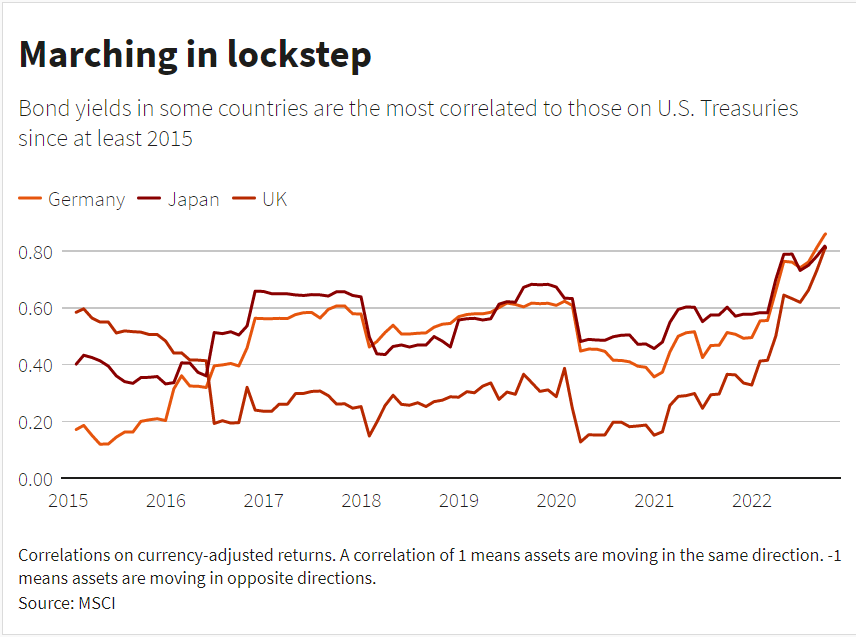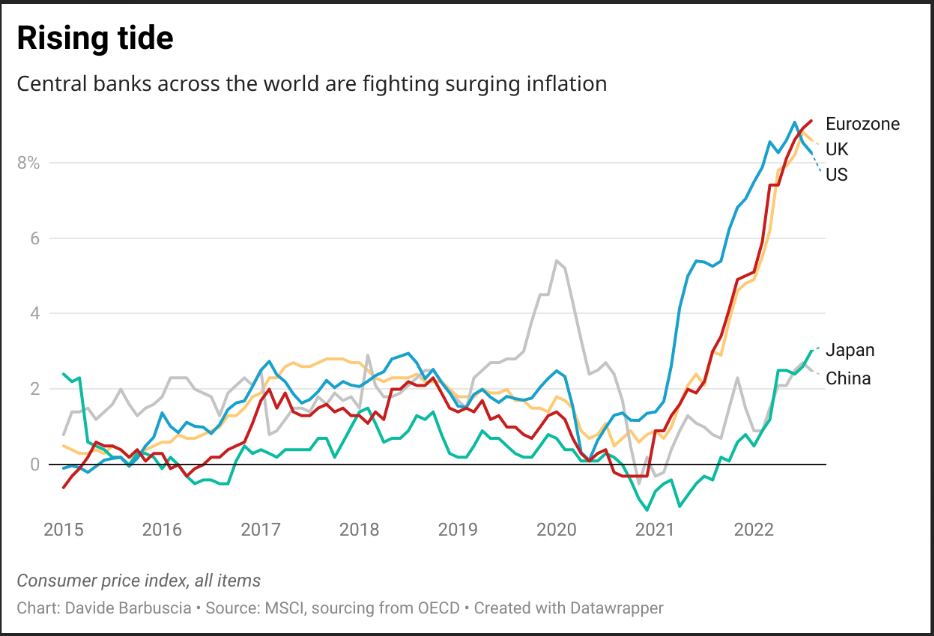Advertisement
Advertisement
Analysis-Global bonds move in lockstep, ramping up investors’ risk
By:
By Davide Barbuscia NEW YORK(Reuters) - Government bond prices around the world are moving in tandem, reducing investors’ ability to diversify their portfolios and raising concerns of being blindsided by market gyrations.
By Davide Barbuscia
NEW YORK(Reuters) – Government bond prices around the world are moving in tandem, reducing investors’ ability to diversify their portfolios and raising concerns of being blindsided by market gyrations.
Correlations between currency-adjusted returns on the government debt of countries such as the U.S., Japan, the U.K. and Germany are at their highest level in at least seven years, data from MSCI showed, as central banks around the world ramp up their fight against inflation.
Increasingly, that means investors holding the debt of one country can see their portfolios slammed by market activity at the other end of the globe. A recent example came late last month, when U.S. yields surged along with those on British government debt after the UK’s tax cut plan roiled markets, then declined sharply once the Bank of England bought long-dated UK bonds to restore financial stability and the government reversed its plans.
“Central banks around the world are combating a common enemy and are largely using the same tools. As a result, we’re seeing significantly elevated correlations between bond markets,” said Andy Sparks, head of portfolio management research at MSCI.
“This greater interdependence between markets runs the risk of creating significant spillover effects, as one market’s pain has quickly transferred to other markets this year,” he said.

The lockstep moves are another strike against the market for government debt, often viewed as among the safest of investments.
U.S. Treasuries and other sovereign debt have plummeted alongside equity markets this year as central banks across the world raise interest rates to tame inflation, pushing up yields on government bonds, which move inversely to prices. Episodes of sparse liquidity in the Treasury market have exacerbated wild price swings, keeping some investors on the sidelines.
Sovereign bonds trading in tandem also hamper investors seeking to distribute their risk exposure globally, in a year where many diversification strategies, including the traditional portfolio weighted 60% stocks and 40% bonds, have underperformed as stocks and bonds get hit together.
“The high level of correlation across global bond markets means that allocating to ex-U.S. bonds is that much less effective,” said Gregory Peters, co-chief investment officer at PGIM Fixed Income.
Peters doesn’t expect the correlations to moderate until central banks’ monetary policies diverge significantly, and he has reduced his exposure to sovereign bonds outside the U.S.

As most central banks march in the same direction, speculation that one country may be letting up in its fight against inflation could fan hopes that other policymakers will eventually follow suit, sparking gyrations in sovereign debt worldwide.
Yields on the U.S. 10-year Treasury, for instance, dipped sharply last week after Australia’s central bank delivered a smaller rate hike than expected, with some investors using the move to support the idea that the Fed will eventually follow suit. U.S. bonds tumbled and stocks dropped later in the week, as a parade of Fed speakers hammered home the U.S. central bank’s single-minded focus on inflation while robust employment data bolstered the case for more hawkishness.
“We’ve always talked about the U.S. exporting its monetary policy, and what we’re starting to see is other countries being able to, on a more global basis, export their policies,” said Bill Campbell, portfolio manager for the DoubleLine Global Bond Strategy Fund. “That’s something that brings these global issues on U.S. investors’ radars, because they are becoming first order market drivers.”
Nonetheless, some investors believe that divergences in monetary policy are likely to appear soon, sparked in part by smaller economies that may have less tolerance than the U.S. for monetary tightening.
Martin Harvey, portfolio manager of the Hartford World Bond Fund, expects monetary policy regimes to start diverging next year. He’s looking at markets such as Australia, New Zealand, Norway and Sweden for opportunities.
“We see the potential for interest rates to be capped in those countries and the potential for them to reverse quickly if the negative impact of rising rates is felt acutely as we go into next year,” he said.
(Reporting by Davide Barbuscia; Editing by Ira Iosebashvili and Leslie Adler)
About the Author
Reuterscontributor
Reuters, the news and media division of Thomson Reuters, is the world’s largest international multimedia news provider reaching more than one billion people every day. Reuters provides trusted business, financial, national, and international news to professionals via Thomson Reuters desktops, the world's media organizations, and directly to consumers at Reuters.com and via Reuters TV. Learn more about Thomson Reuters products:
Latest news and analysis
Advertisement
